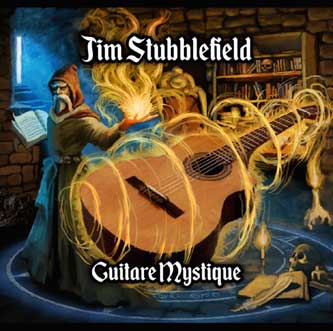 In
2015, guitarist / composer Jim Stubblefield released his album
Encantado and in 2017 he returns with Guitare Mystique.
Purposely spelled in a mystical way, the ten track album takes
on a wide range of musical styles, including a kind of ancient-sounding
approach to the magical guitar. Guitare Mystique picks up on
the approach of Encantado as well as Jim’s work with the
band Incendio, yet there’s more new ground broken here. Using
the Contemporary Instrumental sound as a jumping off point, there’s
a range of inspired-sounding guitar genres explored, including a slightly
gothic or even medieval sort of sound. For example, the addition of
strings on track seven “Moonlight Requiem” gives the track
a sort of modern neoclassical sound, kind of Electric Light Orchestra
sans vocals, if you can imagine. Track nine, “Rumba Furiosa,
Opus 2” features Jim supported by the daredevil electric guitar
work of guitar ace Dan Sistos. Jim has chosen a remarkable
bunch of musicians to help execute his sound on Guitare Mystique,
including co-producer and album mixer Bo Astrup, guitarists
Stephen Duros, Dan Sistos (mentioned above) and Eric Hansen,
bass ace Randy Tico, drummers Ramon Yslas and Bryan
Brock as well as Moksha Sommer (vocals) and Novi Novog
(strings). The CD sound is first rate and the album artwork is
colorful and quite imaginative, all adding to the sense of fun and
excitement. Guitare Mystique takes the entire 21st century
Contemporary / World Fusion instrumental guitar sound to new heights.
Start to finish, Guitare Mystique is clearly the most well-rounded
album yet from the imaginative, guitar-centric mind of Jim Stubblefield.
www.GuitarraExotica.com
In
2015, guitarist / composer Jim Stubblefield released his album
Encantado and in 2017 he returns with Guitare Mystique.
Purposely spelled in a mystical way, the ten track album takes
on a wide range of musical styles, including a kind of ancient-sounding
approach to the magical guitar. Guitare Mystique picks up on
the approach of Encantado as well as Jim’s work with the
band Incendio, yet there’s more new ground broken here. Using
the Contemporary Instrumental sound as a jumping off point, there’s
a range of inspired-sounding guitar genres explored, including a slightly
gothic or even medieval sort of sound. For example, the addition of
strings on track seven “Moonlight Requiem” gives the track
a sort of modern neoclassical sound, kind of Electric Light Orchestra
sans vocals, if you can imagine. Track nine, “Rumba Furiosa,
Opus 2” features Jim supported by the daredevil electric guitar
work of guitar ace Dan Sistos. Jim has chosen a remarkable
bunch of musicians to help execute his sound on Guitare Mystique,
including co-producer and album mixer Bo Astrup, guitarists
Stephen Duros, Dan Sistos (mentioned above) and Eric Hansen,
bass ace Randy Tico, drummers Ramon Yslas and Bryan
Brock as well as Moksha Sommer (vocals) and Novi Novog
(strings). The CD sound is first rate and the album artwork is
colorful and quite imaginative, all adding to the sense of fun and
excitement. Guitare Mystique takes the entire 21st century
Contemporary / World Fusion instrumental guitar sound to new heights.
Start to finish, Guitare Mystique is clearly the most well-rounded
album yet from the imaginative, guitar-centric mind of Jim Stubblefield.
www.GuitarraExotica.com
mwe3.com presents an interview with
JIM STUBBLEFIELD
The Guitare Mystique Interview
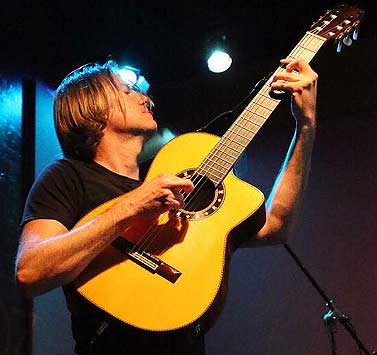 mwe3:
When did you write the music for the Guitare Mystique album
and how did you arrive at the title of the album? Is the new album
a continuation of Encantado or did you travel on some new sonic
destinations on Guitare Mystique?
mwe3:
When did you write the music for the Guitare Mystique album
and how did you arrive at the title of the album? Is the new album
a continuation of Encantado or did you travel on some new sonic
destinations on Guitare Mystique?
Jim Stubblefield: I wrote the music for Guitare Mystique
in the Spring and Fall of 2016. The gap between Encantado and
this album is only two years in terms of release date which is unusual
for me. For instance, Rhythm Of The Heart came out in 1998
and I did not produce another solo album until Guitarra Exotica,
which was released in 2007!
Guitare Mystique is certainly part of an evolution that began
to emerge on Encantado, but there were hints of it on Guitarra
Exotica way back in 2007. Some of the more 'orchestrated' pieces
on Encantado like “Terra e Sole”, which features
a lot of orchestral strings, paved the way for pieces like “Voyager
Aeternam” and “Moonlight Requiem”. Guitare Mystique
is French for 'Mystical Guitar'. I think the title speaks to more
of the atmospheric compositions on the project.
mwe3: Why did you decide to have other guitar players on the
Guitare Mystique CD and what do they bring to the mix? I was
surprised that Mark Barnwell isn’t on Guitare Mystique
as you guys seem to be so much on the same wavelength. Do you prefer
recording as the sole guitarist or do you like other guitarists adding
to the mix as you do in the Incendio albums? Compare the differences.
Jim Stubblefield: I really enjoy working with other musicians
and I think that is one of the great things for me about doing my
"solo" projects. I've been part of the band Incendio since
we officially formed in 1999 and the core group of myself, JP Durand
and Liza Carbé has been a constant. The collaboration of the
three of us, along with other musicians who have drifted in and out
of the ranks over the years, has created what I think is a unique
take on the Latin or "world-fusion" guitar genre. The dialogue
between JP and me is very different in terms of style even though
we predominantly play nylon-string guitars in Incendio. It's that
dialogue that is also very important to what the band's sound is.
On my earlier solo projects, like Guitarra Exotica and Inspiración,
I'm the only guitarist. For Encantado and Guitare Mystique
I did have a number of guest guitarists. It's not really a matter
of preferring to work with other guitarists, it's a matter of whether
or not I feel a song could benefit from a collaboration. The three
guest guitarists on Guitare Mystique are good friends of mine
as well as great artists in their own right. I like the idea of working
with different musicians as I continue to release solo projects. I'm
sure people will hear more music that features Mark Barnwell and I
in the future.
mwe3: On your 2015 album Encantado, you said you tried
to move away from the Latin sound and so on Guitare Mystique
did the sound further evolve? Some of the Guitare Mystique
tracks have a bit of a rock energy to it, like “Moonlight Requiem”
has a bit of an ELO sound. Is that what the use of strings adds to
your sound?
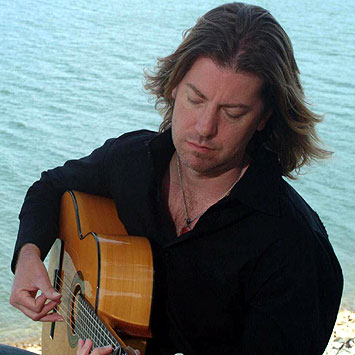 Jim Stubblefield:
I think I'm slowly moving back to my musical roots in terms of what
I grew up listening to. As a teenager I really gravitated towards
rock and fusion bands that tended to push the envelope in terms of
song structure, production and musicianship. On the instrumental side,
I loved Al Di Meola's early solo albums like Land Of The Midnight
Sun and Elegant Gypsy. His song titles, “Flight Over
Rio”, “Race With The Devil”, “On The Spanish Highway’
and his use of percussion and synthesizers could evoke very cool images
and that stuck with me.
Jim Stubblefield:
I think I'm slowly moving back to my musical roots in terms of what
I grew up listening to. As a teenager I really gravitated towards
rock and fusion bands that tended to push the envelope in terms of
song structure, production and musicianship. On the instrumental side,
I loved Al Di Meola's early solo albums like Land Of The Midnight
Sun and Elegant Gypsy. His song titles, “Flight Over
Rio”, “Race With The Devil”, “On The Spanish Highway’
and his use of percussion and synthesizers could evoke very cool images
and that stuck with me.
I also loved British progressive rock bands like Genesis, YES and
Pink Floyd. Guitare Mystique really has elements of progressive
rock and classical music while, on some pieces, I still give nods
to the Latin or exotic guitar style music most people are used to
hearing from me.
mwe3: Tell us about track three “Azure” as it has
some unusual sounds on it. It’s a brilliant track. Are you playing
keyboards more on that track? Are there also guitars on that track?
Does every Guitare Mystique track have guitars on it?
Jim Stubblefield: I play all the keyboards and synthesizers
on the album, but the parts are not all that demanding. “Azure”
is a piece where Novi Novog’s viola takes center stage. There
are a ton of guitars on “Azure”, but they are in a supportive
role. There are multiple tracks of me playing clean electric guitars
using suspended chords and arpeggios throughout the song. The clean
guitar voicings are definitely inspired by Andy Summers of The Police
and Alex Lifeson of Rush. The song itself is a result of what I would
call an English prog-rock influence that I've been revisiting. In
recent years, I have spent a lot of time listening to Pink Floyd as
well as artists like Steven Wilson of Porcupine Tree and Steve Hackett.
“Azure”, to me, has a bit of a melancholy atmosphere to
it. I also made a decision that just because I'm a guitarist, it does
not mean that every piece of music needs to have the guitar as the
main voice. To me, the composition takes priority. The long, legato
and mournful melody of “Azure” sounds more appropriate on
a bowed instrument than on a guitar. I think a big part of my evolution
as a producer, and an important part of my solo projects, is that
the composer side of me is more important than than the guitarist
side of me. That being said, every song on Guitare Mystique has
a fair amount of guitar on it although some guitars might not sound
like guitars. I used an E-bow on some of my electric guitar parts
on the project.
mwe3: You’ve once again picked some great artwork for
the Guitare Mystique album. Tell us about the artwork and how
it enhances the album overall? On the cover art, it looks like Merlin
is about to cast his spell!
 Jim Stubblefield:
The artwork for Encantado and Guitare Mystique were
done by my friend Ben Woods. For both albums, I told Ben what I wanted
and he took it to a whole new level. Incidentally, Ben Woods is a
phenomenal guitarist and has released a ton of albums of his own.
In fact, he finished the artwork of Guitare Mystique only a
week before he left for a European tour as part of Steve Stevens'
band. If you look closely to the cover art you can see that the wizard's
book has music in it. I'm a big fan of fantasy literature and so it
was time I incorporated that love into some album artwork. I also
really like evocative covers such as Kansas' Point Of Know Return
and Leftoverture.
Jim Stubblefield:
The artwork for Encantado and Guitare Mystique were
done by my friend Ben Woods. For both albums, I told Ben what I wanted
and he took it to a whole new level. Incidentally, Ben Woods is a
phenomenal guitarist and has released a ton of albums of his own.
In fact, he finished the artwork of Guitare Mystique only a
week before he left for a European tour as part of Steve Stevens'
band. If you look closely to the cover art you can see that the wizard's
book has music in it. I'm a big fan of fantasy literature and so it
was time I incorporated that love into some album artwork. I also
really like evocative covers such as Kansas' Point Of Know Return
and Leftoverture.
mwe3: “Before The Storm” is another low key track
that features keyboards and some well placed female vocals. Did you
set out to create a kind of mysterious sounding “quiet storm”
track on “Before The Storm”?
Jim Stubblefield: I didn't over-think it. I just had a cool
electric piano sound and a percussion groove that seemed to create
a nice atmospheric tune. Originally the whole album was going to be
a 'chill-out lounge' thing, but as I continued to work on the music
other moods arose. The album does tend to have a flow, which is deliberate.
It begins fairly mellow and atmospheric and gets more 'progressive'
as it runs its course.
mwe3: How about your guitars of choice on Guitare Mystique?
Last time on Encantado you used a 2003 Pedro Maldonado Flamenco
Negra cutaway. How about on the new CD and what about the electrics
and any steel string guitars this time around? Are you still using
the Mesa Boogie amps? Any other guitar news or tech news of interest
for you? What are some of your other favorite Flamenco and Classical
string guitars and what strings do you prefer on both your Flamenco,
classical and electric guitars?
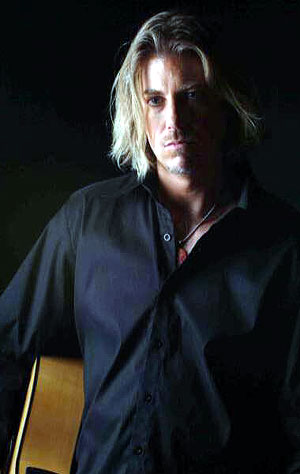 Jim Stubblefield:
I used my 2003 Pedro Maldonado Flamenco Negra cutaway almost exclusively
on Encantado, with the exception of the electric guitar parts.
Incidentally, I sold that guitar to Mark Barnwell in 2016. For Guitare
Mystique I used German Vazquez Rubio, Jorge de Zofia and Maldonado
flamenco guitars. The electric guitars I used included a Fender Stratocaster,
a Fender Telecaster, and a 7-string Musicman John Petrucci Majesty.
For amplification I used a Mesa Boogie Mark V amplifier and the Positive
Grid Bias amp modeling software. I'm using Luthier, Savarez and Galli
strings on my nylon-string guitars. I'm always switching gauges and
strings, but for my electric guitars I've been using Ernie Ball strings.
I use Jim Dunlop Jazz III, Gravity and Blue Chip picks depending on
the sound I want.
Jim Stubblefield:
I used my 2003 Pedro Maldonado Flamenco Negra cutaway almost exclusively
on Encantado, with the exception of the electric guitar parts.
Incidentally, I sold that guitar to Mark Barnwell in 2016. For Guitare
Mystique I used German Vazquez Rubio, Jorge de Zofia and Maldonado
flamenco guitars. The electric guitars I used included a Fender Stratocaster,
a Fender Telecaster, and a 7-string Musicman John Petrucci Majesty.
For amplification I used a Mesa Boogie Mark V amplifier and the Positive
Grid Bias amp modeling software. I'm using Luthier, Savarez and Galli
strings on my nylon-string guitars. I'm always switching gauges and
strings, but for my electric guitars I've been using Ernie Ball strings.
I use Jim Dunlop Jazz III, Gravity and Blue Chip picks depending on
the sound I want.
mwe3: On “Café Café” you join forces
with guitarist Eric Hansen, who lives in South Florida. How did you
meet Eric and what other projects have you worked on with Eric over
time? What did you think of his latest solo album Glistening?
Thanks to you, I was made aware of him. Also tell us about Eric transcribing
your music. Do you plan on having a songbook with your written music?
Jim Stubblefield: Eric and I first came to know each other
back in 1998. Our music was featured on a compilation album called
Pure Flamenco Nuevo Flamenco Passion. Eric had two songs on
the album as did I. Other artists on the compilation included Ottmar
Liebert and Govi. In 2015 Eric was a guest artist on Encantado
and in 2016 I was a guest artist on the song “Silverlight”
from his latest album - Glistening. I have a bunch of pieces
transcribed by Eric, at least a dozen. Many are available for sale
via my website. I first became aware of Eric's transcription skills
through the work he did for Strunz & Farah.
mwe3: “Voyager Aeternam” has a strange title. What
does it mean? It’s very New Age in that it’s quite tempered
and steady. Is that another track featuring your keyboard work? There’s
some nice electric guitar work on that track which offers a cool contrast
to the string sounds.
Jim Stubblefield: “Voyager Aeternam” means ‘Eternal
Voyager’ and is my favorite piece on the album. It's definitely
an atmospheric piece that features keyboards, synthesizers and Novi
Novog playing multiple tracks of violin and viola. I play the keyboards
and there are lots of guitars on this piece. Clean electrics washed
in delay, E-bow and a nylon-string guitar solo.
mwe3: Track seven “Moonlight Requiem” follows “Voyager
Aeternam” with a similar type of sonic vibe. I was thinking there
was a kind of instro ELO vibe on that track when the overdubbed strings
come in. Did you set out to write a kind of 'requiem' type song in
a minor key? Would you consider “Moonlight Requiem” to be
a kind of modern day classical music or is it still Guitar-centric
World Beat?
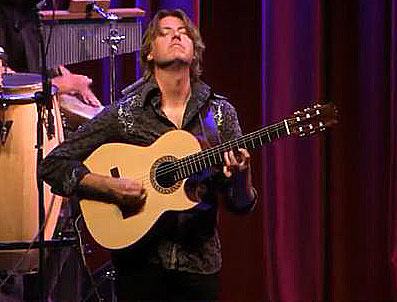 Jim Stubblefield:
Style-wise, I have no idea what it is, but I can speak to its influences.
I would say the song is part Hans Zimmer, part Tangerine Dream and
part classical guitar. I tend to write mostly in minor keys so the
title has less to do about the key and more to do about atmosphere.
The thing I like about instrumental music is that it allows the listener
to create their own images in their mind's eye. The song titles are
more guide posts than anything else.
Jim Stubblefield:
Style-wise, I have no idea what it is, but I can speak to its influences.
I would say the song is part Hans Zimmer, part Tangerine Dream and
part classical guitar. I tend to write mostly in minor keys so the
title has less to do about the key and more to do about atmosphere.
The thing I like about instrumental music is that it allows the listener
to create their own images in their mind's eye. The song titles are
more guide posts than anything else.
mwe3: Track 8 “Oculus Tempestatis” has a kind of
World Beat sound, almost Arabic sounding. There’s some great
soloing on that track. Are you playing all the guitar parts and what
guitars are you playing on that track? Was the guitar solo improvised
and who is doing the female vocal parts?
Jim Stubblefield: “Oculus” features my friend Stephen
Duros playing lower octaves, harmonies and trading guitar solos with
me. He plays the 2nd and 4th guitar solos. Stephen has several wonderful
albums out and he toured as a second guitarist/keyboardist with Ottmar
Liebert for 4 years. The electric guitars on the song are played by
me. Moksha Sommer of the band HuDost sings in her 'non-lyric vocal'
trademark way. She also was a guest on my previous album Encantado.
mwe3: Track nine “Rumba Furiosa, Opus 2” gets
back to a more traditional Rumba Flamenco guitar sound. Did that track
signal a return to the Latin flavored sound of Incendio? Is that Dan
Sistos playing those mean electric guitar parts? It sounds like there’s
at least two electrics playing away on that. Does Dan play all the
electric parts on “Rumba Furiosa, Opus 2”? What can you
tell us about Dan Sistos, when did you meet him and what do you like
best about his music?
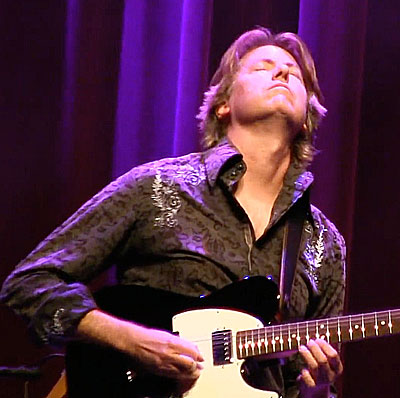 Jim Stubblefield:
The song is a 'traditional' rumba with a big twist that I don't think
has ever been done before. The idea was combining a syncopated rumba
Latin guitar piece with Yngwie Malmsteen / Neoclassical electric guitar
influences. The harpsichord 16th notes doubling the electric guitars
and Gothic style vocal chants I believe are a first in the context
of what would be a typical rumba. Dan and I both perform on acoustic
and electric guitar on the piece. During the bridge we both play electric
as we follow the harpsichord part and harmonize each other. After
the nylon-string guitar solos, all of the electric guitars until the
end of the song are performed by Dan. I've known Dan Sistos for several
years and we've become great friends. Dan is an amazing guitarist
who has played with Christina Aguilera and many other pop stars. He
is the guitarist on the Assassin's Creed video game soundtracks as
well. I also blame him for getting me into expensive Scottish whiskey.
Jim Stubblefield:
The song is a 'traditional' rumba with a big twist that I don't think
has ever been done before. The idea was combining a syncopated rumba
Latin guitar piece with Yngwie Malmsteen / Neoclassical electric guitar
influences. The harpsichord 16th notes doubling the electric guitars
and Gothic style vocal chants I believe are a first in the context
of what would be a typical rumba. Dan and I both perform on acoustic
and electric guitar on the piece. During the bridge we both play electric
as we follow the harpsichord part and harmonize each other. After
the nylon-string guitar solos, all of the electric guitars until the
end of the song are performed by Dan. I've known Dan Sistos for several
years and we've become great friends. Dan is an amazing guitarist
who has played with Christina Aguilera and many other pop stars. He
is the guitarist on the Assassin's Creed video game soundtracks as
well. I also blame him for getting me into expensive Scottish whiskey.
mwe3: Guitare Mystique closes out with “Sueño
Pacifico”. It’s almost a lighthearted way to close out the
album. Did you choose to close the CD out with a positive, fleet-fingered
track? With the cool electric solo it almost has a kind of Santana
like effect.
Jim Stubblefield: The last song is definitely a lighthearted
sendoff. The album tends to be fairly dark and brooding. I thought
it would be fun to end the album on a less moody note.
mwe3: Many of the great guitarists these days are on the West
Coast. Does it seem like a bigger challenge than ever to bring your
music all over the US these days? Are you happy with the way your
music has been accepted worldwide and what else are you planning this
year and into the near future?
Jim Stubblefield: Honestly, most of my newer fans seem to be
outside the United States. I have quite a few followers in South America
and even Eastern Europe although with Pandora, Spotify and Apple Music
featuring my music, things seem to be balancing out now. Of course,
there are fans of Incendio, who also enjoy my solo projects and a
large percentage of those folks are based in the USA.
 For
my solo project, I'm planning to do some very selective live performances
to support Guitare Mystique, but it's too early to say when
or where. My other plans are to continue to evolve as an artist -
both as a solo act and in various collaborative environments. In closing,
I also want to give credit to the other musicians on the album for
really bringing this project to life - Randy Tico (bass), Bryan Brock
(percussion), Ramon Yslas (percussion), Novi Novog (viola and violin),
and Moksha Sommer (vocals). Lastly I want to thank Bo Astrup for co-producing
and doing a wonderful job mixing this album!
For
my solo project, I'm planning to do some very selective live performances
to support Guitare Mystique, but it's too early to say when
or where. My other plans are to continue to evolve as an artist -
both as a solo act and in various collaborative environments. In closing,
I also want to give credit to the other musicians on the album for
really bringing this project to life - Randy Tico (bass), Bryan Brock
(percussion), Ramon Yslas (percussion), Novi Novog (viola and violin),
and Moksha Sommer (vocals). Lastly I want to thank Bo Astrup for co-producing
and doing a wonderful job mixing this album!



